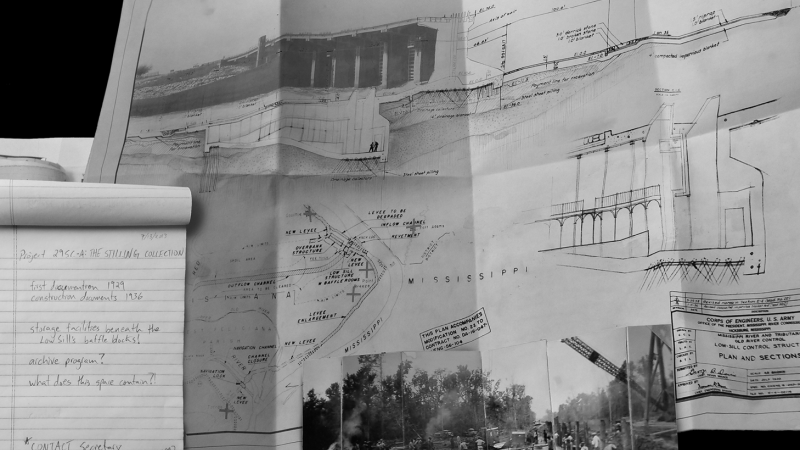After the Great Flood: Recovering Impossible Histories of the US Army Corps of Engineers
After the Great Flood: Recovering Impossible Histories of the US Army Corps of Engineers, an exhibit co-curated by Kristi Cheramie, associate professor in landscape architecture at the Knowlton School, and Matthew Seibert, opens October 28 in Campbell Hall at the University of Virginia.
The exhibition marks the third installation of this body of work, opening first in the Banvard Gallery of the Knowlton School in 2016, in 2018 at University of Illinois Urbana-Champaign, and now at the University of Virginia.

“Our work combines archival and speculative documents from the US Army Corps of Engineers (USACE) during the organization's most feverish time of design and construction, the years immediately following the Great Flood of 1927,” explained Cheramie. “During this period, the USACE formed its institutional mandate alongside each new experiment and each new flood control structure. During this period, the USACE unwittingly entered an environmental arms race only to become the most influential landscape designer in U.S. history.”
The exhibition uses selections from the archives of the US Army Corps of Engineers as a point of departure to explore the material and cultural consequences of flood management in the Lower Mississippi River Basin. Following catastrophic flooding in 1927, the Corps pledged to prevent future flood events, escalating protection efforts with a new suite of federally mandated infrastructure. Publicly the Corps guaranteed progress but internally, the Corps struggled to reconcile management with loss, safety with fragmentation and dislocation. The Corps archives reveal an institution divided, suggesting a host of alternative futures and the starting point for this exhibition.
“Our work operates collectively as a critique of our histories kept, lost and forgotten. We see design as a tool to project both forward and backward in time; to work on the formation and decay of space; and to explore the sociotechnical imaginaries that shape our landscape,” commented Cheramie on her collaborative work with Seibert. “This results in a new landscape methodology—parafictional design research—splicing future-oriented, scenario-building with grounded, rigorous archival research.”
The Exhibition Opening + Talk with Kristi Cheramie and Matthew Seibert will be held on October 28, 2019 at 5pm in Campbell Hall 153. The exhibition will be on display from October 28 - November 25 in the Elmaleh, Salon and Corner Galleries, Campbell Hall, on the University of Virginia campus.

Kristi Cheramie is an associate professor and the chair of undergraduate studies in landscape architecture at the Knowlton School. Her research employs alternate practices of spatial history to explore erasure, loss and forgetting as powerful agents of change in the landscape. Using speculation as a tool to reconstruct the historical systems, scales, and materials that comprise a landscape, she looks to design to reveal the interconnections between story, memory, ground, and time. Her work, largely based in fieldwork, tracks patterns of adaptability and transformation in the landscape, with a particular focus on efforts aimed at mitigating or eliminating change.
Matthew Seibert’s work has largely focused on critical representation. Landscape Metrics, a visualization studio originally co-founded with a systems ecologist and geospatial web developer in 2015, specialized in animation, interactive cartography, and science communication for clients ranging from government, private practice, and academia. In addition to this more conventional work, Seibert employs representation as interrogative and speculative tools within historical trajectories, crafting rich parafictions as both critique and potential future.


